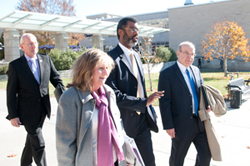November 21, 2011
Nuclear Regulatory commissioner visits K-State, tours research reactor
Submitted by Communications and Marketing

Today, 10 times more students are taking courses in nuclear engineering than 20 years ago, according to William D. Magwood, a commissioner of the U.S. Nuclear Regulatory Commission.
Magwood visited Kansas State University on Thursday, Nov. 17, to meet with administers and nuclear engineering faculty and students, and to learn more about the university's nuclear engineering program.
"Kansas State University is one of the nation's leaders in nuclear engineering education," said April Mason, university provost. "We were the third U.S. university to create a nuclear engineering program, and are one of a few that has continued to maintain its research reactor on campus, benefiting our students and faculty. It's our advantage with programs like these that will make K-State a top 50 public research university by 2025."
As part of his visit, Magwood spoke with students and toured the university's nuclear research laboratories and research reactor, which is coming up on its 50th anniversary.
"If you go back to the early 1990s there were 60 or so research reactors in the country," Magwood said. "Now we're down to about 24, so each one is more and more important. Kansas State University has enhanced and expanded its reactor over the years and has continued research with it, making the university a real leader in this field. I was quite impressed with that."
Outside of nuclear engineering, Magwood said K-State is also proving to be a leader across the various disciplines of engineering, as evidenced by its partnerships with engineering programs and other universities.
"One of my former positions in the Department of Energy was helping schools work together and leverage their resources in a more efficient way," Magwood said. "Kansas State does that, and perhaps even more successfully than I had imagined back when I first thought about something like this."
Magwood is the longest-serving head of the nation's civilian nuclear technology program, serving two presidents and two secretaries of energy from 1998-2005. He oversaw the restoration of the federal nuclear technology program and led the creation of several initiatives that helped increase nuclear technology education in the U.S.
This fall K-State began offering a minor in nuclear engineering to professionals and engineering students across the country. More about the minor can be read at http://www.k-state.edu/media/newsreleases/jul11/nukeminor71311.html.
Submitted by Communications and Marketing, 532-2535, vpcm@k-state.edu.
